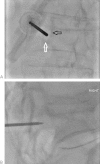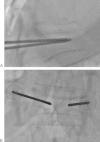Vertebroplasty
- PMID: 24436552
- PMCID: PMC3773069
- DOI: 10.1055/s-0033-1353483
Vertebroplasty
Abstract
Percutaneous vertebroplasty has become widely accepted as a safe and effective minimally invasive procedure for the treatment of painful vertebral body compression fractures refractory to medical therapy. In this article, the authors review the indications and contraindications for vertebroplasty, principles of appropriate patient selection, useful techniques to achieve optimal outcomes, and the potential risks and complications of the procedure.
Keywords: interventional radiology; kyphoplasty; osteoporosis; vertebral augmentation; vertebral compression fracture; vertebroplasty.
Figures










Similar articles
-
Vertebral augmentation.Handb Clin Neurol. 2021;176:379-394. doi: 10.1016/B978-0-444-64034-5.00017-1. Handb Clin Neurol. 2021. PMID: 33272406 Review.
-
Minding the Gap in Vertebroplasty: Vertebral Body Fracture Clefts and Cement Nonunion.Pain Physician. 2021 Mar;24(2):E221-E230. Pain Physician. 2021. PMID: 33740359
-
[Vertebroplasty and kyphoplasty : A critical statement].Radiologe. 2020 Feb;60(2):138-143. doi: 10.1007/s00117-020-00651-z. Radiologe. 2020. PMID: 31989205 Review. German.
-
Does Percutaneous Vertebroplasty or Balloon Kyphoplasty for Osteoporotic Vertebral Compression Fractures Increase the Incidence of New Vertebral Fractures? A Meta-Analysis.Pain Physician. 2017 Jan-Feb;20(1):E13-E28. Pain Physician. 2017. PMID: 28072794 Review.
-
Percutaneous vertebral augmentation: an elevation in adjacent-level fracture risk in kyphoplasty as compared with vertebroplasty.Spine J. 2007 Sep-Oct;7(5):575-82. doi: 10.1016/j.spinee.2006.10.020. Epub 2007 Jan 24. Spine J. 2007. PMID: 17905320
Cited by
-
Paraplegia due to intradural cement leakage after vertebroplasty: a case report and literature review.BMC Musculoskelet Disord. 2021 Aug 28;22(1):741. doi: 10.1186/s12891-021-04625-7. BMC Musculoskelet Disord. 2021. PMID: 34454446 Free PMC article. Review.
-
Cement augmentation for treatment of high to mid-thoracic osteoporotic compression fractures, high-viscosity cement percutaneous vertebroplasty versus balloon kyphoplasty.Sci Rep. 2022 Nov 12;12(1):19404. doi: 10.1038/s41598-022-22019-0. Sci Rep. 2022. PMID: 36371412 Free PMC article.
-
Percutaneous Vertebral Augmentation Techniques in Osteoporotic and Traumatic Fractures.Semin Intervent Radiol. 2018 Oct;35(4):309-323. doi: 10.1055/s-0038-1673639. Epub 2018 Nov 5. Semin Intervent Radiol. 2018. PMID: 30402014 Free PMC article. Review.
-
Comparative study of Lutetium-177 and Phosphorus-32 in radioactive bone cement for the treatment of vertebral body metastasis.J Cancer Res Clin Oncol. 2023 Aug;149(10):7479-7491. doi: 10.1007/s00432-023-04695-1. Epub 2023 Mar 24. J Cancer Res Clin Oncol. 2023. PMID: 36959343 Free PMC article.
-
Osteoporosis management-current and future perspectives - A systemic review.J Orthop. 2024 Mar 2;53:101-113. doi: 10.1016/j.jor.2024.03.002. eCollection 2024 Jul. J Orthop. 2024. PMID: 38495575 Free PMC article. Review.
References
-
- Leech J A, Dulberg C, Kellie S, Pattee L, Gay J. Relationship of lung function to severity of osteoporosis in women. Am Rev Respir Dis. 1990;141(1):68–71. - PubMed
-
- Borgström F, Zethraeus N, Johnell O. et al.Costs and quality of life associated with osteoporosis-related fractures in Sweden. Osteoporos Int. 2006;17(5):637–650. - PubMed
-
- Silverman S L. The clinical consequences of vertebral compression fracture. Bone. 1992;13 02:S27–S31. - PubMed
-
- Röllinghoff M, Zarghooni K, Schlüter-Brust K. et al.Indications and contraindications for vertebroplasty and kyphoplasty. Arch Orthop Trauma Surg. 2010;130(6):765–774. - PubMed
-
- Kado D M Browner W S Palermo L Nevitt M C Genant H K Cummings S R; Study of Osteoporotic Fractures Research Group. Vertebral fractures and mortality in older women: a prospective study Arch Intern Med 1999159111215–1220. - PubMed
Publication types
LinkOut - more resources
Full Text Sources
Other Literature Sources

